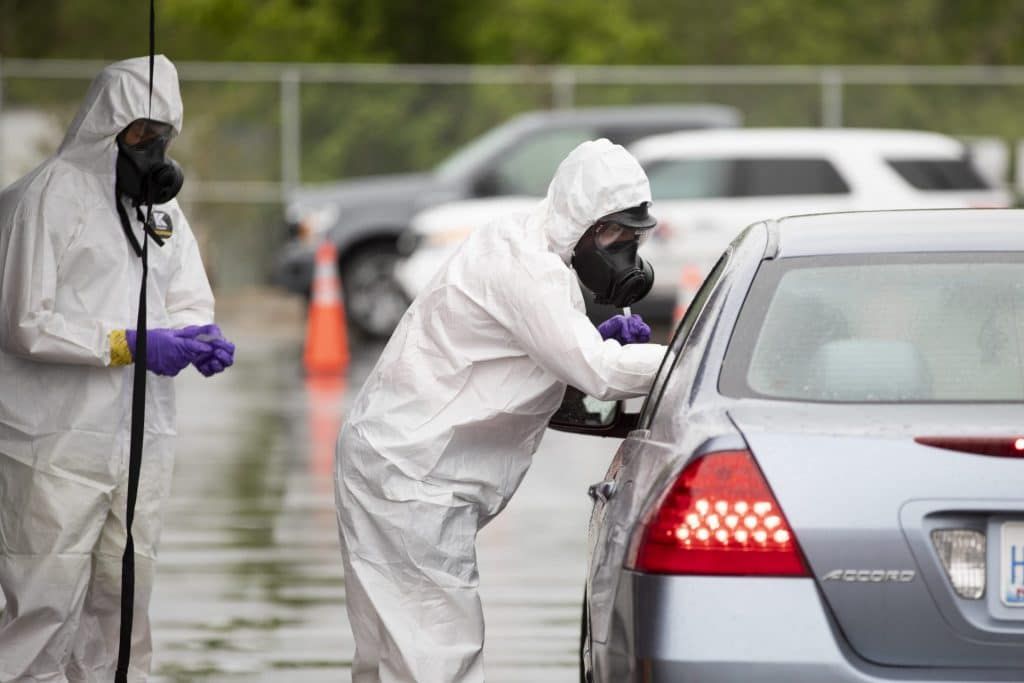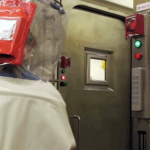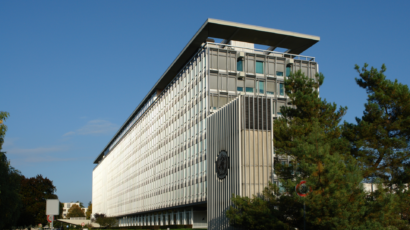How the US gained and then lost the ability to make medical masks
By Vic Suarez | July 25, 2024
 In 2020, as tens of thousands of people in the United States continued to test positive for COVID-19 each week, many wondered if it was really time to reopen the economy. Credit: US Army. CC BY 2.0.
In 2020, as tens of thousands of people in the United States continued to test positive for COVID-19 each week, many wondered if it was really time to reopen the economy. Credit: US Army. CC BY 2.0.
Just a few short years ago, acquiring medical face masks, gloves, and face shields was a challenge akin to securing front-row tickets to a Taylor Swift concert. By mid-2020, the COVID-19 pandemic and subsequent lockdowns had laid bare the United States’s precarious reliance on foreign sources. Seeing states in a cut-throat competition for limited supplies of foreign-made goods, policymakers implemented various measures to address shortfalls. Now personal protective equipment (PPE) is in plentiful supply online and in any retail drugstore. Yet, unfortunately, any notion that the country’s underlying supply chain problem has been resolved is just an illusion—one that masks a grim reality. Far from being in a better place with respect to PPE, the United States now stands on the verge of a near-complete inability to manufacture these critical supplies.
The United States still doesn’t manufacture a significant amount of PPE, and several domestic companies that responded to the call to produce PPE are now closed or on the brink of bankruptcy. With many hospitals struggling to remain financially stable, the US healthcare system has reverted to purchasing cheap and often subpar imports of medical supplies like PPE and syringes from nations with lower quality and safety standards, contributing to a significant supply-chain vulnerability and public-health risk.
Leaders across political parties have been working to address this problem. They should now build on those efforts with specific steps, including a rebate program to use money from import tariffs to support domestic PPE production, expanded efforts to enforce the PPE tariffs already in place, and broadened requirements for US government agencies to purchase masks, gloves, and face shields from domestic suppliers or in nations that fully comply with US quality assurance and competitiveness laws. If US policymakers implement innovative policies and incentives, the country can tackle these issues and safeguard national security and public health.
How domestic PPE cratered. As medical supply chains faltered in 2020, the US government, through the Administration for Strategic Preparedness & Response, invested more than $1 billion in dozens of companies to increase domestic PPE production capacity and create necessary raw materials like the polypropylene, polycarbonate, and polyethylene commonly used in masks. Over a dozen US-based PPE manufacturers, seeing an opportunity to establish new manufacturing lines that could reliably produce and supply higher quality equipment, pivoted to help reduce reliance on overseas sources from late 2020 into 2022. The problem was, just as these capabilities were coming online, demand for PPE waned due to less restrictive masking policies following mass COVID-19 vaccinations of over 70 percent of the US population and a sharp decline in hospitalizations and deaths.
In response, US healthcare organizations, the largest consumers of this PPE, and their purchasing groups reverted to buying from foreign sources the cheapest available PPE they could find. China filled this demand by ramping up production on all aspects of such equipment and flooded the global market with cheap, often low quality and even fraudulent PPE. It’s part of the Made in China 2025 playbook China has mastered to control the pharmaceutical market. The country has implemented the program extremely effectively with essential medical supplies. This situation calls for immediate action to prevent further damage to the US industrial base, the country’s national security, and its public-health capabilities.
To counteract and rebalance this market shift towards Chinese-made PPE, the Biden administration took action early on, using Executive Order 14001 to promote a sustainable public health supply chain. The order required the departments of Defense, Health and Human Services, Homeland Security, and others, to develop actionable plans and mechanisms for domestic production of pandemic supplies, including PPE. This initial positive step even compelled major federal agencies to identify their annual PPE requirements to provide predictability to the marketplace and to award federal contracts with a preference for domestic suppliers.
But US hospitals and their supply purchasers have continued to procure foreign-made PPE mainly due to its low cost and plentiful supply. Medical distribution firms whose business models aim to achieve the lowest cost, with little attention to threshold levels of quality. were responsible for acquiring most PPE, which are sometimes accompanied by misleading claims that these products were cleared for sale by from the Food and Drug Administration.
How to boost critical supplies. Following an in-depth analysis in May, the Biden administration announced a series of increased tariffs under the Trade Act of 1974 to protect American workers and businesses from China’s unfair trade practices. Tariff rates for PPE, including respirators and face masks, will increase from 0 to 7.5 percent. Some of these products will face an even higher 25-percent tariff this year. The tariff on medical and surgical gloves will increase from 7.5 percent to 25 percent in 2026. Although this is an excellent first step in countering the flood of cheap and low-quality PPE into the US market, it does not go far enough to incentivize large health care buyers to purchase domestic PPE, nor does it make targeted use of tariff collections to create sustainable domestic sources of production.
There are three near-term actions that the US government could take to reduce these PPE vulnerabilities.
First, all tariffs on Chinese-made PPE should be collected into a special fund controlled by a designated government entity that would dedicate it to a “PPE rebate program” to incentivize domestic production. This type of program would enable any high-volume purchasers of PPE who procure bona fide US-made PPE to receive a significant reimbursement in their following year’s taxes if they demonstrate they purchased American-made PPE (for example, a 25 percent rebate, depending on tariff levels).
Second, the Department of Commerce and Department of Homeland Security should be mandated to work with the US Trade Representative to investigate all instances of Chinese-made PPE being diverted through intermediaries to avoid tariffs. They must prioritize shutting down the distribution of fraudulent PPE, especially equipment that does not have Food and Drug Administration clearance and poses a threat to public health while undermining domestic manufacturers and distributors.
Third, the United States must keep strengthening the Make PPE in America Act that was part of the 2021 Bipartisan Infrastructure Law. It directed the Department of Homeland Security, the Department of Health and Human Services, and the Veteran’s Administration to sustain and expand PPE manufacturing in the United States. Policymakers should build on that progress with requirements for the Department of Defense to source only American-made PPE, with limited exceptions. There should also be a requirement that PPE purchases for the Strategic National Stockpile be sourced from domestic or Trade Agreement Act-compliant manufacturers, with limited exceptions.
By purchasing imported PPE, mainly from China, the US healthcare system has reverted to pre-pandemic behaviors that pose grave geopolitical and health security risks. In coordination with industry, the federal government is responsible for protecting workers, at-risk patients, and the general public by implementing and promoting a more domestic, resilient, diversified, and enduring supply chain and manufacturing base for personal protective equipment.
Together, we make the world safer.
The Bulletin elevates expert voices above the noise. But as an independent nonprofit organization, our operations depend on the support of readers like you. Help us continue to deliver quality journalism that holds leaders accountable. Your support of our work at any level is important. In return, we promise our coverage will be understandable, influential, vigilant, solution-oriented, and fair-minded. Together we can make a difference.
Keywords: Coronavirus, masks
Topics: Biosecurity
















Reverting to pre-pandemic behaviors in ways that leave us less safe… why does that sound so familiar?
Companies spun up PPE production only to take government dollars. As soon as they met requirements they spun them down and sold all the equipment, and it was bought and sent to China. Here is one story on the auction of ppe manufacturing supplies barely 2 years old- https://finance.yahoo.com/news/multi-million-dollar-equipment-auction-130000794.html
I edited (but did not write!) the first ASTM test method for N95 and N99 masks — mainly for protection against factory and mining dusts — more than 50 years ago. I noted that China was due to upgrade its KN95 test protocol in July 2020 and delayed that due to possible production disruptions. I agree that when it comes to quality of attachment points, Chinese masks don’t tend to take much abuse… but these tyoes of masks are not meant to be worn multiple times. Any allegation that Chinese or other non-USA masks offer inferior protection against dust or… Read more »